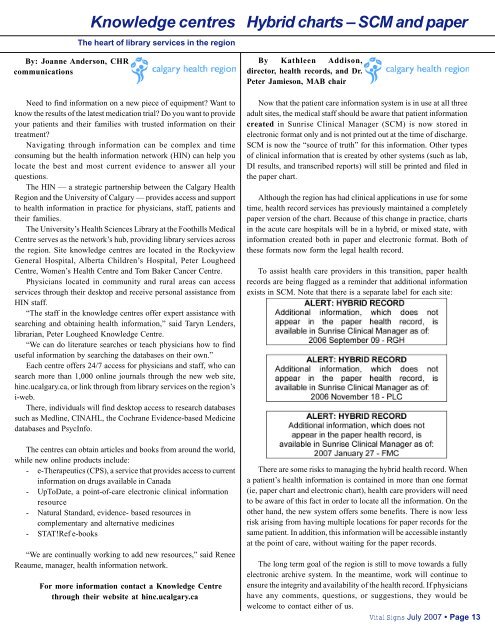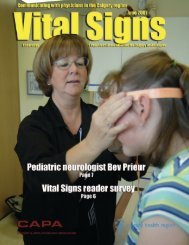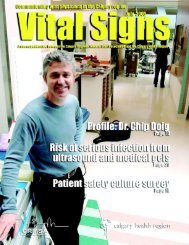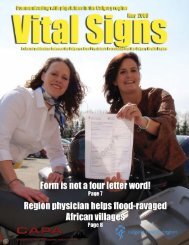July 2007 Vital Signs.p65 - Calgary & Area Physician's Association
July 2007 Vital Signs.p65 - Calgary & Area Physician's Association
July 2007 Vital Signs.p65 - Calgary & Area Physician's Association
You also want an ePaper? Increase the reach of your titles
YUMPU automatically turns print PDFs into web optimized ePapers that Google loves.
By: Joanne Anderson, CHR<br />
communications<br />
Knowledge centres<br />
The heart of library services in the region<br />
Need to find information on a new piece of equipment? Want to<br />
know the results of the latest medication trial? Do you want to provide<br />
your patients and their families with trusted information on their<br />
treatment?<br />
Navigating through information can be complex and time<br />
consuming but the health information network (HIN) can help you<br />
locate the best and most current evidence to answer all your<br />
questions.<br />
The HIN — a strategic partnership between the <strong>Calgary</strong> Health<br />
Region and the University of <strong>Calgary</strong> — provides access and support<br />
to health information in practice for physicians, staff, patients and<br />
their families.<br />
The University’s Health Sciences Library at the Foothills Medical<br />
Centre serves as the network’s hub, providing library services across<br />
the region. Site knowledge centres are located in the Rockyview<br />
General Hospital, Alberta Children’s Hospital, Peter Lougheed<br />
Centre, Women’s Health Centre and Tom Baker Cancer Centre.<br />
Physicians located in community and rural areas can access<br />
services through their desktop and receive personal assistance from<br />
HIN staff.<br />
“The staff in the knowledge centres offer expert assistance with<br />
searching and obtaining health information,” said Taryn Lenders,<br />
librarian, Peter Lougheed Knowledge Centre.<br />
“We can do literature searches or teach physicians how to find<br />
useful information by searching the databases on their own.”<br />
Each centre offers 24/7 access for physicians and staff, who can<br />
search more than 1,000 online journals through the new web site,<br />
hinc.ucalgary.ca, or link through from library services on the region’s<br />
i-web.<br />
There, individuals will find desktop access to research databases<br />
such as Medline, CINAHL, the Cochrane Evidence-based Medicine<br />
databases and PsycInfo.<br />
The centres can obtain articles and books from around the world,<br />
while new online products include:<br />
- e-Therapeutics (CPS), a service that provides access to current<br />
information on drugs available in Canada<br />
- UpToDate, a point-of-care electronic clinical information<br />
resource<br />
- Natural Standard, evidence- based resources in<br />
complementary and alternative medicines<br />
- STAT!Ref e-books<br />
“We are continually working to add new resources,” said Renee<br />
Reaume, manager, health information network.<br />
For more information contact a Knowledge Centre<br />
through their website at hinc.ucalgary.ca<br />
Hybrid charts – SCM and paper<br />
By Kathleen Addison,<br />
director, health records, and Dr.<br />
Peter Jamieson, MAB chair<br />
Now that the patient care information system is in use at all three<br />
adult sites, the medical staff should be aware that patient information<br />
created in Sunrise Clinical Manager (SCM) is now stored in<br />
electronic format only and is not printed out at the time of discharge.<br />
SCM is now the “source of truth” for this information. Other types<br />
of clinical information that is created by other systems (such as lab,<br />
DI results, and transcribed reports) will still be printed and filed in<br />
the paper chart.<br />
Although the region has had clinical applications in use for some<br />
time, health record services has previously maintained a completely<br />
paper version of the chart. Because of this change in practice, charts<br />
in the acute care hospitals will be in a hybrid, or mixed state, with<br />
information created both in paper and electronic format. Both of<br />
these formats now form the legal health record.<br />
To assist health care providers in this transition, paper health<br />
records are being flagged as a reminder that additional information<br />
exists in SCM. Note that there is a separate label for each site:<br />
There are some risks to managing the hybrid health record. When<br />
a patient’s health information is contained in more than one format<br />
(ie, paper chart and electronic chart), health care providers will need<br />
to be aware of this fact in order to locate all the information. On the<br />
other hand, the new system offers some benefits. There is now less<br />
risk arising from having multiple locations for paper records for the<br />
same patient. In addition, this information will be accessible instantly<br />
at the point of care, without waiting for the paper records.<br />
The long term goal of the region is still to move towards a fully<br />
electronic archive system. In the meantime, work will continue to<br />
ensure the integrity and availability of the health record. If physicians<br />
have any comments, questions, or suggestions, they would be<br />
welcome to contact either of us.<br />
<strong>Vital</strong> <strong>Signs</strong> <strong>July</strong> <strong>2007</strong> • Page 13





